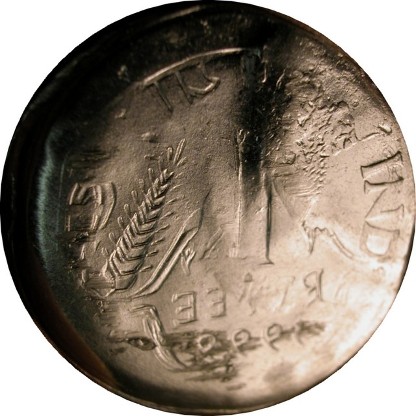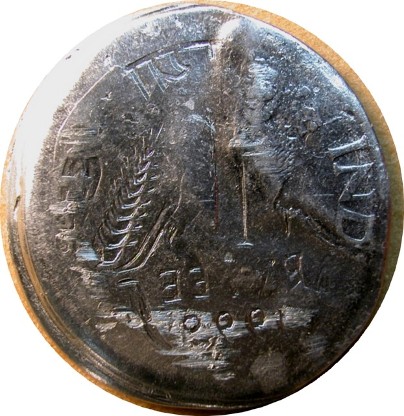PART VI. Striking Errors:
Counterbrockages:
Brockage-Counterbrockage Combination (8 types):
There are eight ways in which such a combination may occur. All are rare.
Several are represented by an actual example. Others remain entirely theoretical. For the theoretical, visual reconstruction is presented of the conditions immediately preceding the production of the brockage-counterbrockage error.
1) Counterbrockage/clashed cap strike.
A “clashed cap” is a die cap that collides with the opposite die when a planchet fails to be fed into the striking chamber. A “clashed cap strike” is a planchet that is struck by such a cap. A clashed cap strike is a type of brockage.
A counterbrockage/clashed cap strike occurs when an obverse die cap that is striking counterbrockages collides with the reverse die when a planchet fails to enter the striking chamber. The working face of the die cap picks up a die-struck reverse design, which is often incomplete owing to the reduced thickness of the floor of the cap. The next several coins that are struck feature intermingled brockage and counterbrockage design elements. The brockaged elements are derived from the clash, while the counterbrockage elements are from the original incuse design on the working face of the die cap.
Permutations: This scenario could also apply to a reverse (anvil) die cap.
A typical counterbrockage/clashed cap strike. The counterbrockage elements include much of Lincoln’s bust (e.g., his coat and ear), the numbers “19”, and the letters “BER”. These were generated by the original incuse design on the working face of the die cap, elements that were not obliterated by the clash. The incuse, mirror-image Memorial design elements are sharp, normal-sized, and undistorted, indicating that this coin was struck immediately after the cap clashed with the reverse die. The largely featureless swelling on the right side of the obverse face of this Lincoln cent represents an area of the cap that was indented by a planchet that intruded into the striking chamber.
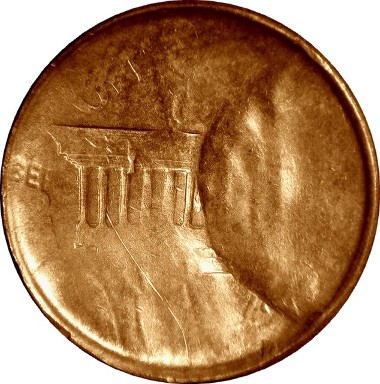
2) A die cap that is producing brockages is, in turn, brockaged by a struck cent that intrudes into the striking chamber.
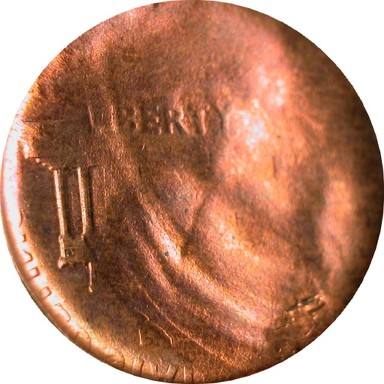
3) A coin inserts itself between a die cap that is producing counterbrockages and an underlying planchet.
See example & images of 1967 India 50 paise below.
Permutations: This scenario could also conceivably occur with an anvil die cap.
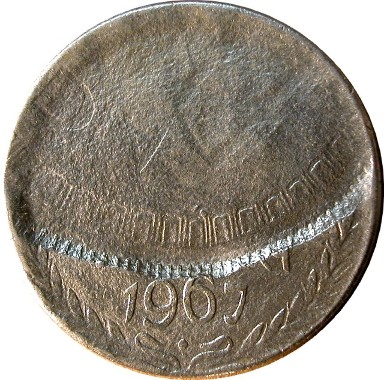
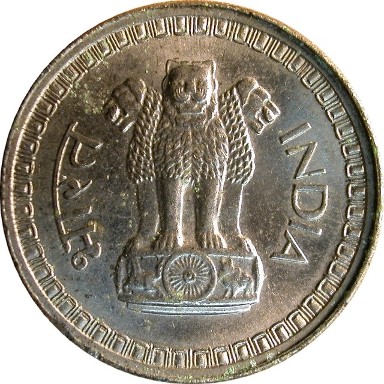
Such an error has not been found among U.S. coins, however. The distinctive result of such an event has been seen in coins from Argentina, Brazil, Costa Rica, and Canada.
1) Part of the reverse face shows a first-strike brockage of the obverse design.
2) The rest of the reverse face shows a counterbrockage of the reverse design. The counterbrockage would rest on top of a bulge or plateau located on the reverse face of the affected coin.
Below is a Brazil 2 cruzeiros (1942-1956) that was struck into an underlying coin with a partial brockage. On the reverse you can see a raised, normally-oriented version of the bottom of the 2 and the word CRUZEIROS. Above that is a brockage of the southern end of the country of Brazil. Since the counterbrockage is properly aligned with the die-struck obverse design, it’s likely that the brockage that generated it was itself the product of a first strike by a partial (off-center) die cap.
Permutations: This error could also develop on a planchet fed in beneath an error coin that featured a partial brockage of the obverse design on the reverse face.
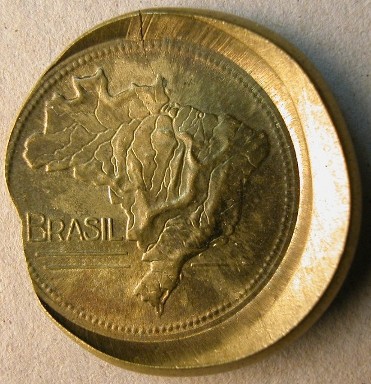
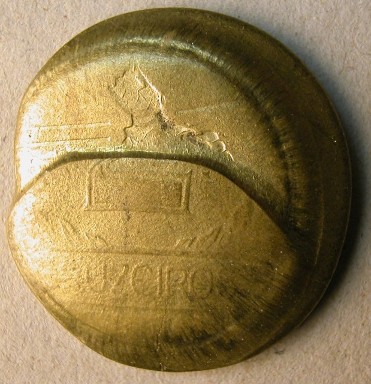
5) A planchet is fed in on top of a normal coin and a brockaged coin.
The normal coin and the brockaged coin would lie side-by-side within the striking chamber or would overlap. One possible arrangement is shown below. This particular combination in any coin, foreign or domestic has yet to be found.
Permutations: This error could naturally appear on a planchet fed in beneath two coins, one normal and one with a brockage of the obverse design on the reverse face.
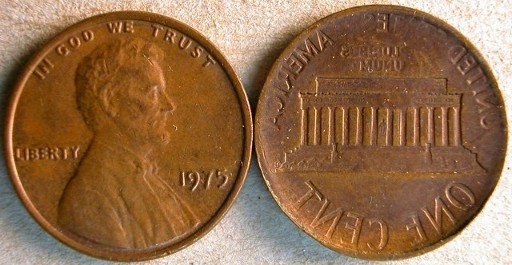
The second, off-center strike leaves a brockage on the part of the coin that was in direct contact with the second coin. The image below shows such an error, a double-struck 1972-D nickel with a first-strike brockage of the obverse design on the reverse face of the second strike.
If a fresh planchet were to be fed beneath this double-struck coin (or if this coin was fed on top of a planchet), the result would be a coin with a brockage and a counterbrockage that lie side-by-side. Some brockaged elements would likely persist within the counterbrockage. This error type has not been encountered.
Permutations: The brockage could be on the obverse face or the reverse face. The planchet would respectively rest on top of, or beneath, the brockage.
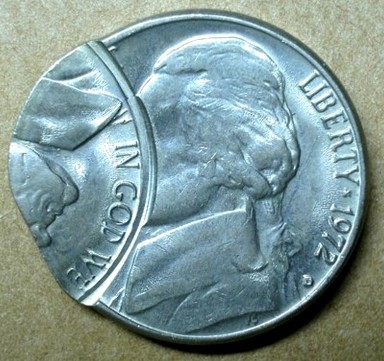
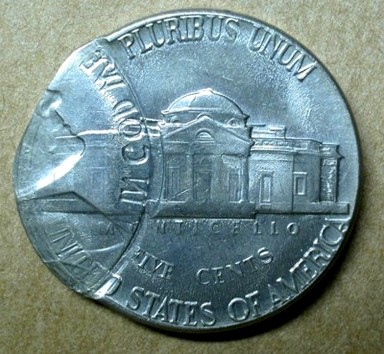
The eight scenarios presented above represent the simplest paths to a brockage-counterbrockage error. Naturally, things can get much more complicated. A case in point is this 1999 India 1 rupee coin shown further below.
The obverse face (struck by the anvil die) features a mixture of brockage and counterbrockage design elements over the entire surface, with the brockage dominating. The brockage is an incuse, mirror-image version of the reverse (hammer) die design, which features the numeral 1, the date, and the stalks of grain. It is neither enlarged nor appreciably distorted, indicating it is a first-strike brockage. The brockage shows close doubling. An exception to the dominance of the brockage is the northeast quadrant where a counterbrockage dominates. It mainly shows the three-headed lion and the letters IND (of INDIA) – the motifs of the anvil die. The counterbrockage shows no expansion and little distortion, which would indicate that it, is a first-strike counterbrockage. The counterbrockage elements in the northeast quadrant occupy a low plateau that is elevated above the rest of the obverse face, including
the scattered counterbrockage elements found elsewhere. The die-struck reverse design on the opposite face – the face struck by the hammer die – shows evidence of only one strike.
In a normal 1 rupee coin of this year, the center of the die-struck lion’s middle face is even with the apex of the number 1 on the opposite face. The center of the counterbrockage lion’s middle face is located several millimeters up and to the left of the die-struck “1”. Their significantly dislocated position (relative to the die-struck face), and their
elevated position are clear signs that the lion and the letters IND are counterbrockage elements (as opposed to mashed first-strike, die-struck design elements).
The steps necessary to produce this specimen are enumerated below.
1. A coin is struck normally or is, perhaps, a minor broadstrike.
2. The coin sticks to the hammer die.
3. A planchet intrudes into the northwest corner of the striking chamber and is struck off-center. The anvil die strikes only the off-center coin, not the die cap. This may have been due to insufficient die approximation.
4. The off-center coin sticks to the underside of the die cap as a partial die cap. The unstruck portion of the partial die cap protrudes beyond the confines of the striking chamber.
5. The full die cap and partial die cap are struck into a planchet fed in beneath them. This produces a centered, mirror brockage and a partial, aligned brockage in the northwest corner of the newly struck coin. The partial, aligned brockage is recessed relative to the main brockage. There is little or no horizontal offset between the centered brockage and the aligned brockage. (An “aligned brockage” is one whose incuse design is aligned with the corresponding normal die-struck design on the opposite face.)
6. The full die cap and partial die cap fall off and are ejected.
7. The bottom coin (with the centered and aligned brockages) is struck twice (die-struck on both faces), with slight movement of the coin between strikes. The brockage is 80% obliterated, except in the northwest quadrant, which was recessed and therefore largely protected.
8. A fresh planchet is fed in on top of this coin and struck. The bottom face of this planchet ends up with a double brockage (from the close double strike of step 7) and a counterbrockage (from step 5) in the northeast quadrant.
This extraordinary chain of events is not likely to be repeated. But, then again, half of the eight simpler scenarios presented have yet to be documented.
A 1999 India 1 rupee coin with an exceedingly complex brockage-counterbrockage error on the obverse face. The obverse face was struck by the anvil die.
